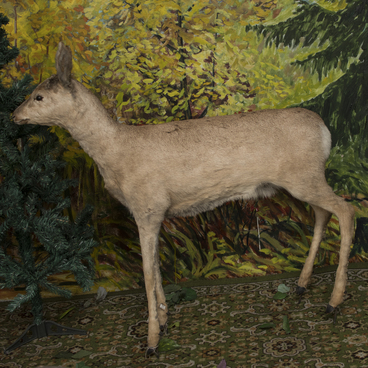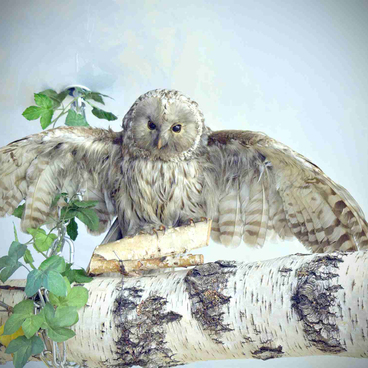The muskrat is a mammal from the Arvicolinae sub-family of the order Rodentia. It is a semiaquatic rodent native to North America, which was introduced in parts of Eurasia, including Russia. In the latter, its natural habitat stretches from the border with Finland across the entire wooded region of European Russia and most of the forest steppes and taiga of Siberia to the Far East and the Kamchatka Peninsula.
Its coat is this animal’s main source of pride. It consist of a soft underfur and a coarser outer coat. The color of the muskrat’s fur changes from dark brown or even black on its back and legs to lighter hues on its belly. In summers, the entire body becomes fairer on color. The coat is highly water-resistant. The animal is also a stickler for cleanliness. It regularly brushes its fur and rubs its fat on it. Hence, its coat glistens and shimmers in the sun.
Muskrats mainly eat cabbage, bulrush and other plants, that grow in the water and on the shores. The less discriminating of the species can also feed on shellfish, crustaceans, frogs, fish and dead remains if any of these food sources are in abundance. The muskrat is incredibly well-adapted to its aquatic lifestyle. The tops of its ears barely stick out of its fur, and the eyes are positioned high up on its head. The animal’s lips, just as those of beavers, seal behind its incisors, hence it can chew plants under water without swallowing any water in the process. Muskrats lead semi-aquatic lifestyles and inhabit the shores of rivers, lakes, canals and particularly gladly, of freshwater swamps. They prefer being in shallow waters and shores covered with dense vegetation. These animals can live in natural water bodies as well as artificial ones. But muskrats cannot be found in or near water bodies that freeze during the winter. One can come across these animals on the outskirts of towns and cities. The presence of humans does not frighten them. They are active all day and night long, most frequently after sunset and early in the morning. Muskrats feed on aquatic plants and those that grow on shores of water bodies, such as bulrush, reed and sedges. In spring time, these mammals eat young stalks and leaves; in summers and autumns, they consume plant parts near their roots and in winters, only roots. Their diet can also include cultivated crops.
Muskrats make their burrows on high banks of water bodies. These shelters can be 2 meters in length. Inside, there are usually several exits and tunnels, which lead to the water. These passages are often dug out at different levels in case the water in the nearby lake, river, etc. rises. Muskrats also construct special storage chambers, where they stock up on food for colder seasons. On the ground, these animals are somewhat slow, but they do swim and dive really well. The mammals can remain underwater without coming up for air for 17 minutes. Muskrats live in family groups and have their own territories. They each have their own feeding grounds and chase any interlopers out of there.
Its coat is this animal’s main source of pride. It consist of a soft underfur and a coarser outer coat. The color of the muskrat’s fur changes from dark brown or even black on its back and legs to lighter hues on its belly. In summers, the entire body becomes fairer on color. The coat is highly water-resistant. The animal is also a stickler for cleanliness. It regularly brushes its fur and rubs its fat on it. Hence, its coat glistens and shimmers in the sun.
Muskrats mainly eat cabbage, bulrush and other plants, that grow in the water and on the shores. The less discriminating of the species can also feed on shellfish, crustaceans, frogs, fish and dead remains if any of these food sources are in abundance. The muskrat is incredibly well-adapted to its aquatic lifestyle. The tops of its ears barely stick out of its fur, and the eyes are positioned high up on its head. The animal’s lips, just as those of beavers, seal behind its incisors, hence it can chew plants under water without swallowing any water in the process. Muskrats lead semi-aquatic lifestyles and inhabit the shores of rivers, lakes, canals and particularly gladly, of freshwater swamps. They prefer being in shallow waters and shores covered with dense vegetation. These animals can live in natural water bodies as well as artificial ones. But muskrats cannot be found in or near water bodies that freeze during the winter. One can come across these animals on the outskirts of towns and cities. The presence of humans does not frighten them. They are active all day and night long, most frequently after sunset and early in the morning. Muskrats feed on aquatic plants and those that grow on shores of water bodies, such as bulrush, reed and sedges. In spring time, these mammals eat young stalks and leaves; in summers and autumns, they consume plant parts near their roots and in winters, only roots. Their diet can also include cultivated crops.
Muskrats make their burrows on high banks of water bodies. These shelters can be 2 meters in length. Inside, there are usually several exits and tunnels, which lead to the water. These passages are often dug out at different levels in case the water in the nearby lake, river, etc. rises. Muskrats also construct special storage chambers, where they stock up on food for colder seasons. On the ground, these animals are somewhat slow, but they do swim and dive really well. The mammals can remain underwater without coming up for air for 17 minutes. Muskrats live in family groups and have their own territories. They each have their own feeding grounds and chase any interlopers out of there.



